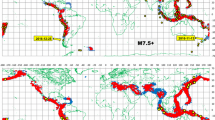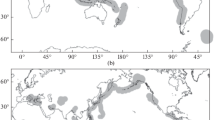Abstract
In the course of the ongoing since 1992 Global Test of the intermediate-term middle-range earthquake forecast/predictions by the algorithms M8 and MSc place and time of each of the mega-earthquakes of 27 February 2010 in Chile and 11 March 2011 in Japan were recognized as in state of increased probability of such events in advance their occurrences. In conjunction with a retrospective analysis of seismic activity preceding the first of a series of mega earthquakes of the 21st century, i.e., 26 December 2004 in the Indian Ocean, these evidences give grounds for assuming that the algorithms of proven validated effectiveness in magnitude ranges M7.5+ and M8.0+ can be applied to predict the mega-earthquakes as well.
Similar content being viewed by others
References
Allen, C.R., Edwards, W., Hall, W.J., Knopoff, L., Raleigh, C.B., Savit, C.H., Toksoz, M.N., and Turner, R.H., Predicting Earthquakes: A Scientific and Technical Evaluation-with Implications for Society, Washington: U.S. National Academy of Sciences, National Research Council, Panel on Earthquake Prediction of the Committee on Seismology, Assembly of Mathematical and Physical Sciences, 1976.
Global Hypocenters Data Base, Denver, 1989.
Healy, J.H., Kossobokov, V.G., and Dewey, J.W., A Test to Evaluate the Earthquake Prediction Algorithm, M8/US Geol. Surv. Open-File Report 92-401, 1992.
Keilis-Borok, V.I. and Kossobokov, V.G., Periods of Increased Probability of Strong Earthquakes of the World, in Matematicheskie metody v seismologii i geodinamike (Mathematical Methods in Seismology and Geodynamics), New York: Allerton Press, 1986, pp. 47–57; Moscow: Nauka, 1986, pp. 48–58; Vychisl. Seismol., 1988, issue 19.
Keilis-Borok, V. I. and Kossobokov, V.G., Premonitory Activation of Seismic Flow: Algorithm M8, Phys. Earth Planet. Int., 1990, vol. 61, pp. 73–83.
Kossobokov, V.G., Keilis-Borok, V.I., and Smith, S.W., Localization of Intermediate-Term Earthquake Prediction, J. Geophys. Res., 1990, vol. 95, no. B12, pp. 19763–19772.
Kossobokov, V.G. and Turcotte, D.L., A Systematic Global Assessment of the Seismic Risk, EOS Trans., 1996, vol. 77, no. 46.
Kossobokov, V.G., 26 December 2004 Greatest Asian Quake: When to Expect the Next One?, in Statement at Special Session on the Indian Ocean Disaster: Risk Reduction for a Safer Future. UN World Conference on Disaster Reduction, Kobe, Jan. 18–22, 2005a.
Kossobokov, V.G., Prognoz zemletryasenii: osnovy, realizatsiya, perspektivy (Earthquake Forecasting: Fundamentals, Implementation and Perspectives), Moscow: GEOS, 2005b; Earthquake Forecasting and Geodynamic Processes, Vychisl. Seismol., 2005b, issue 36, part 1.
Kossobokov, V., Romashkova, L., and Nekrasova, A., Targeting the Next Mega-Earthquake, in Proc. EGU General Assembly, Vienna, April 13–18, 2008; Geophys. Res. Abstr., 2008, vol. 10.
Kossobokov, V.G., Romashkova, L.L., and Nekrasova, A.K., Targeting the Next Mega-Earthquake: The 27 February 2010 Chile Case, EOS Trans. AGU, 2010, vol. 91, no. 26.
Latchman, J.L., Morgan, F.D., and Aspinall, W.P., Temporal Changes in the Cumulative Piecewise Gradient of a Variant of the Gutenberg-Richter Relationship, and the Imminence of Extreme Events, Earth Sci. Rev., 2008, vol. 87, pp. 94–112.
Lehman, E., Testing Statistical Hypotheses, Wiley, 1960; Moscow: Nauka, 1979.
Peresan, A., Kossobokov, V., Romashkova, L., and Panza, G.F., Intermediate-Term Middle-Range Earthquake Predictions in Italy: A Review, Earth Sci. Rev., 2005, vol. 69, nos. 1–2, pp. 97–132.
Romashkova, L.L. and Kossobokov, V.G., Concentration Parameters of Foci in the Mid-Term Earthquake Prediction Algorithm, in Sovremennye problem seismichnosti i dinamiki Zemli (Modern Problems of Seismicity and the Dynamics of the Earth), Moscow: Nauka, 1996, pp. 56–66; Vychisl. Seismol., 1997, issue 28.
Romashkova, L., Nekrasova, A., and Kossobokov, V., Seismic Cascades in Advance and after 26 December 2004 Sumatra-Andaman and other Mega-Earthquakes, EOS Trans. AGU Fall Meeting AGU. Suppl., 2005, vol. 86(52), abstr. U11B-0834.
Romashkova, L.L. and Kossobokov, V.G., Global Seismic Symptoms of Lithosphere Instability at the Approach of the December 26, 2004, Sumatra-Andaman Megaearthquake, Dokl. Earth Sci., 2007, vol. 417, no. 8, pp. 1221–1223 [Dokl. Akad. Nauk, 2007, vol. 416, no. 5, pp. 686–689].
Romashkova, L.L., Global-Scale Analysis of Seismic Activity Prior to 2004 Sumatra-Andaman Mega Earthquake, Tectonophysics, 2009, vol. 470, pp. 329–344.
Sobolev, G.A. and Zav’yalov, A.D., On the Concentration Criteria of Seismological Ruptures, Dokl. Akad. Nauk SSSR, 1980, vol. 252, no. 1, pp. 69–71.
Author information
Authors and Affiliations
Additional information
Original Russian Text © V.G. Kossobokov, 2011, published in Geofizicheskie protsessy i biosfera, 2011, Vol. 10, No. 2, pp. 5–21.
The article was translated by the authors.
Rights and permissions
About this article
Cite this article
Kossobokov, V.G. Are mega earthquakes predictable?. Izv. Atmos. Ocean. Phys. 47, 951–961 (2011). https://doi.org/10.1134/S0001433811080032
Published:
Issue Date:
DOI: https://doi.org/10.1134/S0001433811080032




